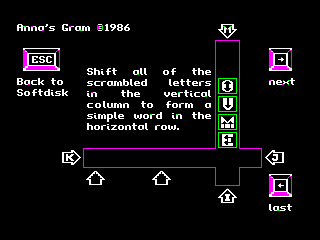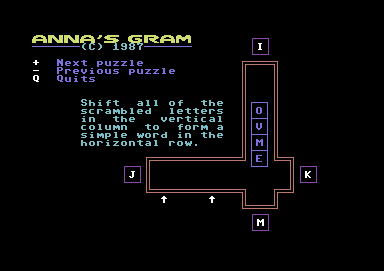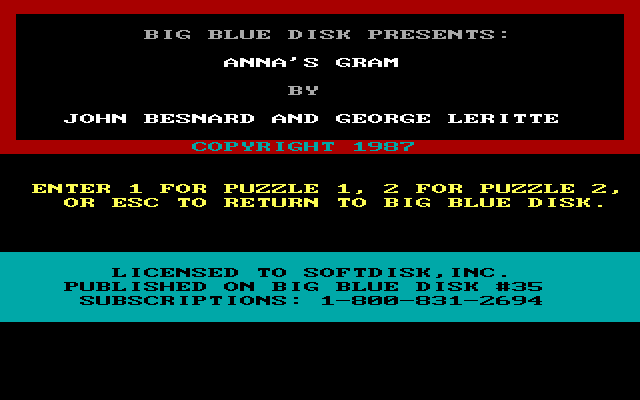Retro Replay Review
Gameplay
Anna’s Gram presents a fresh twist on classic word puzzles by marrying sliding‐tile mechanics with a dynamic letter‐arrangement system. Players are given a confined grid in which tiles bearing individual letters must be slid, swapped, or rotated to form target words. Each puzzle challenges your spatial reasoning as much as your vocabulary, making for a satisfying mental workout that scales in difficulty as you progress through dozens of curated stages.
(HEY YOU!! We hope you enjoy! We try not to run ads. So basically, this is a very expensive hobby running this site. Please consider joining us for updates, forums, and more. Network w/ us to make some cash or friends while retro gaming, and you can win some free retro games for posting. Okay, carry on 👍)
One of the most engaging aspects of Anna’s Gram is its simultaneous multi‐word design. Rather than tackling one word at a time, you’ll often find yourself juggling several partial solutions on the same board. The position of a single tile can influence not just the current word but also feed letters into a downstream puzzle, creating a cascading effect that rewards foresight and planning.
Originally featured on multiple Softdisk disk subscriptions, Anna’s Gram’s puzzles vary with each platform release, ensuring a tailored experience whether you’re playing on an early PC, Amiga, or Apple II. This recurring‐feature approach means that no two installments feel identical: you’ll encounter new letter sets, fresh grid shapes, and expanding rule constraints that keep the gameplay loop invigorating and unpredictable.
The learning curve is gentle at first—you begin with short, three‐ or four‐letter words and a spacious grid. As you advance, grids shrink, words lengthen, and the puzzle branches grow more complex. By the time you’re deciphering a five‐word chain where each final letter seeds the next word, Anna’s Gram has you thinking several moves ahead, offering a rich blend of strategy and linguistic creativity.
Graphics
Built on the modest hardware of Softdisk’s early platforms, Anna’s Gram embraces a clean, uncluttered visual style that prioritizes function over flair. Letter tiles are rendered in crisp, high‐contrast font, ensuring readability even on low‐resolution screens. Grids, borders, and UI elements are straightforward, guiding your attention squarely to the puzzle at hand.
Despite its minimalist palette, the game incorporates subtle animations—tiles slide smoothly, and completed words gently highlight to celebrate your progress. These small touches inject life into an otherwise static board, offering visual feedback that keeps you connected to each successful arrangement.
The user interface is thoughtfully designed: tooltips and status bars display active word lists, remaining moves, and puzzle objectives without overwhelming the screen. Menus are intuitively laid out, making it easy to select new puzzles, review past solutions, or adjust difficulty settings. Even newcomers to the genre will feel at home within moments of diving in.
Overall, Anna’s Gram proves that compelling puzzle design doesn’t require cutting‐edge graphics. Its simple yet effective visual presentation ensures that the learning curve remains focused on gameplay mechanics, while occasional aesthetic flourishes keep the interface from feeling dated or stagnant.
Story
Unlike many contemporary titles, Anna’s Gram is not driven by an intricate narrative or character arcs. Instead, it frames its puzzle challenges within the abstract concept of “Anna’s letters,” implying that each grid is a new message or riddle sent by a mysterious correspondent. This loose premise provides just enough story context to spark curiosity without detracting from the puzzle‐centric experience.
Every disk subscription release of Anna’s Gram hints at a broader theme: you are deciphering fragments of a larger telegram, each puzzle revealing a snippet of the unknown sender’s thoughts. While the game never delivers a conventional cutscene or dialogue tree, this minimalist storytelling approach fuels player imagination—encouraging you to assign your own meaning to the evolving word chains.
Some players may find the absence of a fleshed‐out storyline surprising, but Anna’s Gram thrives on intellectual discovery rather than plot twists. The real narrative unfolds in the evolving complexity of its puzzles: you witness your own growth as a problem‐solver, connecting thematic dots through letter patterns instead of scripted events.
By focusing on the pure joy of decipherment, Anna’s Gram reminds us that story in puzzle games can be as much about the player’s journey as any scripted tale. Each completed grid feels like uncovering a hidden message, giving you a subtle sense of accomplishment that binds gameplay and implied narrative into a cohesive whole.
Overall Experience
Anna’s Gram delivers a timeless puzzle experience that balances mental rigor with addictive “just‐one‐more” replay value. Whether you’re revisiting classic Softdisk installments or discovering the game for the first time on modern emulation, the core mechanics remain as compelling as ever. The interplay between sliding tiles and word formation creates a unique tension that challenges both spatial and linguistic faculties.
The game’s modular puzzle sets—each tailored to a specific platform release—offer hours of brain‐teasing fun. Casual players will appreciate the early levels’ forgiving nature, while veteran puzzlers can dive into advanced stages where grid real estate shrinks and word chains lengthen. Daily or weekly play sessions feel equally rewarding, whether you have five minutes or an hour to spare.
Although Anna’s Gram lacks flashy production values, its streamlined design and robust mechanics more than compensate. The minimal storyline, clear visual feedback, and thoughtfully paced difficulty curve combine to create an experience that feels polished and purposeful. It’s a testament to how smart design can transcend technological limitations.
For anyone seeking a distinctive word puzzle that rewards both quick thinking and long‐term strategy, Anna’s Gram is an easy recommendation. Its blend of sliding‐tile movement and cascading letter logic sets it apart from conventional word games, delivering a cerebral challenge that will keep enthusiasts coming back for more.
 Retro Replay Retro Replay gaming reviews, news, emulation, geek stuff and more!
Retro Replay Retro Replay gaming reviews, news, emulation, geek stuff and more!








Reviews
There are no reviews yet.